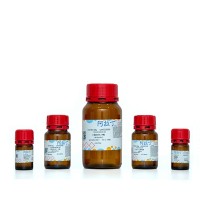Measuring Receptor Target Coverage: A Radioligand Competition Binding Protocol for Assessing the Association and Dissociation Rates of Unlabeled Compo
互联网
- Abstract
- Table of Contents
- Materials
- Figures
- Literature Cited
Abstract
The kinetics of the ligand?receptor interaction is an important feature in lead optimization for new drug candidates. The protocol described in this unit is a kinetic radioligand competition binding assay that makes possible the determination of both the association and dissociation rates of unlabeled receptor ligands. Curr. Protoc. Pharmacol. 50:9.14.1?9.14.30. © 2010 by John Wiley & Sons, Inc.
Keywords: kinetics; radioligand binding; receptor; association rate; dissociation rate
Table of Contents
- Introduction
- Basic Protocol 1: Determination of Bmax and Kd Values by Radioligand Saturation
- Basic Protocol 2: Determination of the Dissociation Rate (koff) of a Radiolabeled Ligand from a Receptor
- Basic Protocol 3: Determination of the Observed Association Rate (kob) of the Radiolabel
- Basic Protocol 4: Competition Kinetics Between [3H]NMS and Unlabeled Ligands
- Support Protocol 1: Preparation of Receptor Membranes from Cultured Cells
- Support Protocol 2: Determination of Unlabeled Competitor Ki Values
- Support Protocol 3: Calculation of Kd and Bmax from Saturation Experiments
- Support Protocol 4: Calculation of Unlabeled Competitor Ki Values from Competition Experiments
- Support Protocol 5: Calculation of the Dissociation Rate (koff) of [3H]NMS
- Support Protocol 6: Calculation of the Association Rate (kon) of [3H]NMS
- Support Protocol 7: Calculation of the Kinetic Rate Constants of Unlabeled Ligands from Competition Binding Experiments
- Reagents and Solutions
- Commentary
- Literature Cited
- Figures
- Tables
Materials
Basic Protocol 1: Determination of Bmax and Kd Values by Radioligand Saturation
Materials
Basic Protocol 2: Determination of the Dissociation Rate (koff) of a Radiolabeled Ligand from a Receptor
Materials
Basic Protocol 3: Determination of the Observed Association Rate (kob) of the Radiolabel
Materials
Basic Protocol 4: Competition Kinetics Between [3H]NMS and Unlabeled Ligands
Materials
Support Protocol 1: Preparation of Receptor Membranes from Cultured Cells
Materials
Support Protocol 2: Determination of Unlabeled Competitor Ki Values
|
Figures
-
Figure 9.14.1 Saturation assay plate map. View Image -
Figure 9.14.2 Dissociation assay plate map. View Image -
Figure 9.14.3 Kinetic association assay plate map. View Image -
Figure 9.14.4 Competition kinetic assay plate map. View Image -
Figure 9.14.5 Competition K i determination assay plate map. View Image -
Figure 9.14.6 Saturation data for the binding of [3 H]NMS to the M3 muscarinic receptor. The mean bound cpm is plotted against the amount of added radioligand (radioligand concentration). Specific binding is the difference between total binding (binding in the absence of atropine) and nonspecific binding (binding in the presence of atropine). The dissociation constant ( K d ) and the ( B max ) values were calculated by globally fitting the data using GraphPad Prism 4. A one‐site binding hyperbola has been fitted through the specific bound for representative purposes. Graph shows data from one experiment, (each point in triplicate) and is represented as mean ± SEM. View Image -
Figure 9.14.7 Inhibition of [3 H]NMS binding to human M3 by the antagonists atropine and tiotropium. Normalized plot of the inhibition of [3 H]NMS binding by the antagonists atropine and tiotropium. The data are presented as percent specific binding. View Image -
Figure 9.14.8 Dissociation of [3 H]NMS from CHO‐M3 membranes. Radioligand (0.05 nM) was incubated with CHO‐M3 membranes (10 µg/ml) for 60 min. The dissociation of radioligand was followed for various time periods after the addition of 1 µM atropine (preventing ligand reassociation), and the reactions terminated by rapid filtration. The nonspecific binding did not vary with time and was subtracted from the total binding to obtain specific bound which is plotted. Data are representative from a single experiment performed in quadruplicate. Data were best fitted using a one‐phase exponential decay function to produce a t 1/2 estimate. This was converted into a k off value by using Equation . View Image -
Figure 9.14.9 Global kinetic association for the simultaneous calculation of k on and k off . Data were fit to the global kinetic association model to simultaneously calculate k on ( k 1 ) and k off ( k 2 ) values for the radioligand. These parameter estimates are then used in the kinetic competition analysis. Each point is the mean ± SEM of six observations from a single experiment. View Image -
Figure 9.14.10 The k on was determined by incubation of CHO‐M3 cell membranes (10 µg/well) with the indicated concentrations of [3 H]NMS for various time periods. Each point is the mean ± SEM of six observations from a single experiment. Data were fitted using a one‐phase exponential association function to yield an observed on‐rate ( k ob ). The k on value was calculated using Equation . View Image -
Figure 9.14.11 k ob plotted against the [3 H]NMS concentration, employed for indirect determination of k on (slope) and k off ( y intercept = 0). In this case data are shown as the individual k ob from a single experiment. View Image -
Figure 9.14.12 [3 H]NMS competition kinetics curves in the presence of atropine (A ) and tiotropium (B ). CHO‐M3 cell membranes were incubated with 1 nM [3 H]NMS and either 0, 10× K i , 30× K i , or 100× K i atropine or 0, 100× K i , 300× K i , or 1000× K i tiotropium. Plates were incubated at room temperature for the indicated time points and NSB levels determined in the presence of 1 µM atropine. Data were fitted to the equations described in to calculate k on and k off values for the unlabeled antagonists. Constraints: k1 = 4.500e+008, L = 1.010, k2 = 0.0140; Fitted: Bmax, k3, and k4 (data summarized in Table ). Data are presented as mean ± SEM experiments performed in quadruplicate. View Image -
Figure 9.14.13 Representative kinetic association experiments for the binding of [3 H]DHA and [125 I]CYP to human β2 receptors. Data are fitted to the global kinetic association model to simultaneously calculate k on and k off values for the radioligand as outlined in . Each point is the mean ± range of duplicate observations from a single experiment. View Image -
Figure 9.14.14 Effect of temperature and buffer on [3 H]NMS binding affinity to M3 receptors. View Image
Videos
Literature Cited
| Literature Cited | |
| Barlow, R.B., Birdsall, N.J., and Hulme, E.C. 1979. Temperature coefficients of affinity constants for the binding of antagonists to muscarinic receptors in the rat cerebral cortex. Br. J. Pharmacol. 66:587‐590. | |
| Barnes, P.J., Belvisi, M.G., Mak, J.C., Haddad, E.B., and O'Connor, B. 1995. Tiotropium bromide (Ba 679 BR), a novel long‐acting muscarinic antagonist for the treatment of obstructive airways disease. Life Sci. 56:853‐859. | |
| Birdsall, N.J., Burgen, A.S., Hulme, E.C., and Wells, J.W. 1979. The effects of ions on the binding of agonists and antagonists to muscarinic receptors. Br. J. Pharmacol. 67:371‐377. | |
| Carter, C.M.S., Leighton‐Davies, J.R., and Charlton, S.J. 2007. Miniaturized receptor binding assays: Complications arising from ligand depletion. J. Biomolec. Screen. 12:255‐266. | |
| Cheng, Y. and Prusoff, W.H. 1973. Relationship between inhibition constant (K1) and concentration of inhibitor which causes 50 percent inhibition (I50) of an enzymatic‐reaction. Biochem. Pharmacol. 22:3099‐3108. | |
| Colquhoun, D. 1968. The rate of equilibration in a competitive n drug system and the auto‐inhibitory equations of enzyme kinetics: Some properties of simple models for passive sensitization. Proc. R. Soc. Lond. B Biol. Sci. 170:135‐154. | |
| Copeland, R.A., Pompliano, D.L., and Meek, T.D. 2007. Drug‐target residence time and its implications for lead optimization. Nat. Rev. Drug. Discov. 5:730‐739. | |
| Disse, B., Speck, G.A., Rominger, K.L., Witek, T.J. Jr., and Hammer, R. 1999. Tiotropium (Spiriva): Mechanistical considerations and clinical profile in obstructive lung disease. Life Sci. 64:457‐464. | |
| Dowling, M.R. and Charlton, S.J. 2006. Quantifying the association and dissociation rates of unlabelled antagonists at the muscarinic M3 receptor. Br. J. Pharmacol. 148:927‐937. | |
| Haddad, E.B., Mak, J.C., and Barnes, P.J. 1994. Characterization of [3H] Ba 679 BR, a slowly dissociating muscarinic antagonist, in human lung: Radioligand binding and autoradiographic mapping. Mol. Pharmacol. 45:899‐907. | |
| Hulme, E.C. and Birdsall, N.J.M. 1992. Strategy and tactics in receptor‐binding studies. In Receptor‐Ligand Interactions. A Practical Approach (E.C. Hulme, ed.) pp. 63‐176. Oxford University Press, New York. | |
| Motulsky, H. and Christopolous, A. 2003. Fitting models to biological data using linear and nonlinear regression: A practical guide to curve fitting. Graphpad Software, San Diego, Calif. | |
| Motulsky, H.J. and Mahan, L.C. 1984. The kinetics of competitive radioligand binding predicted by the law of mass action. Mol. Pharmacol. 25:1‐9. | |
| Mersmann, H.J. and McNell, R.L. 1992. Ligand binding to the porcine adipose tissue β‐adrenergic receptor. J. Anim. Sci. 70:787‐797. | |
| Rang, H.P. 1966. The kinetics of action of acetylcholine antagonists in smooth muscle. Proc. R. Soc. Lond. B Biol. Sci. 164:488‐510. | |
| Smith, D.A., Jones, B.C., and Walker, D.K. 1996. Design of drugs involving the concepts and theories of drug metabolism and pharmacokinetics. Med. Res. Rev. 16:243‐266. | |
| Sykes, D.A., Dowling, M.R., and Charlton, S.J. 2009. Exploring the mechanism of agonist efficacy: A relationship between efficacy and agonist dissociation rate at the muscarinic M3 receptor. Mol. Pharmacol. 76:543‐551. | |
| Summerhill, S., Stroud, T., Nagendra, R., Perros‐Huguet, C., and Trevethick, M. 2008. A cell‐based assay to assess the persistence of action of agonists acting at recombinant human β(2) adrenoceptors. J. Pharmacol. Toxicol. Methods 58:189‐197. | |
| Takahashi, T., Belvisi, M.G., Patel, H., Ward, J.K., Tadjkarimi, S., Yacoub, M.H., and Barnes, P.J. 1994. Effect of Ba 679 BR, a novel long‐acting anticholinergic agent, on cholinergic neurotransmission in guinea pig and human airways. Am. J. Respir. Crit. Care Med. 150:1640‐1645. | |
| Vauquelin, G. and Van Liefde, I. 2006. Slow antagonist dissociation and long‐lasting in vivo receptor protection. Trends Pharmacol. Sci. 27:356‐359. |









